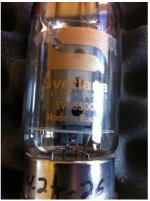If I remember correctly the SV6550C was Svetlana's valve number for their variation of 6550, it was a more ruggedized version. They applied the SV prefix to a lot of there western valve types which they developed. When I say Svetlana I am referring to SED (or winged =C=) which was originally founded in 1889 and is located in St Petersburg, they only manufacture the SV6550C.
Obviously in America you also have the New Sensor 'Svetlana' branded valves which cannot be sold elsewhere in the world branded as Svetlana because Mike Matthews of New Sensor Corp only holds the trademark for the USA. I believe that these are marked up as 6550C and are probably just a rebranded version of one of the Sovtek or Electro-Harmonix valves as is the case with most of the Mullard, Tung Sol, Svetlana and Genelex valves which come from the New Sensor factory.
Obviously in America you also have the New Sensor 'Svetlana' branded valves which cannot be sold elsewhere in the world branded as Svetlana because Mike Matthews of New Sensor Corp only holds the trademark for the USA. I believe that these are marked up as 6550C and are probably just a rebranded version of one of the Sovtek or Electro-Harmonix valves as is the case with most of the Mullard, Tung Sol, Svetlana and Genelex valves which come from the New Sensor factory.
Svetlana was big soviet tube manufacture located in Leningrad. I am living half a mile from Svetlana factory BTW.
Most New Sensor tubes were made in Saratov but branded as "Svetlana" for better marketing.
SED tubes were made on Svetlana facilities but as I recall SED is a new company renting spaces on Svetlana not the original soviet Svetlana.
Most New Sensor tubes were made in Saratov but branded as "Svetlana" for better marketing.
SED tubes were made on Svetlana facilities but as I recall SED is a new company renting spaces on Svetlana not the original soviet Svetlana.
Is this the same factory where SED is currently located ?Svetlana was big soviet tube manufacture located in Leningrad. I am living half a mile from Svetlana factory BTW.
They did also try to copy the look of the SED valves for example on the EL34 they used wire retainers on the mica's and the brown valve bases etc but the bulk of the internals like the anodes were stock Sovtek innards.Most New Sensor tubes were made in Saratov but branded as "Svetlana" for better marketing.
Yes you are correct, my original description was slightly evasive. Svetlana Electron Devices was a US based company which was formed in 1992 but I was under the impression that it was a partnership between Svetlana and the US based company (I could be wrong) and it was this partnership which developed all of the western types of valves using the knowledge and manufacturing equipment in Svetlana St Petersburg. New Sensor purchased the Svetlana brand name from the American SED company when the partnership went wrong only.......they didn't own the Svetlana brand name, that is why the New Sensor Corp can't sell the valves outside of the USA after the Russian SED/Svetlana side of the partnership took New Sensor to court and won.SED tubes were made on Svetlana facilities but as I recall SED is a new company renting spaces on Svetlana not the original soviet Svetlana.
SED was based in Huntsvilla, Alabama and was a joint venture company formed between Svetlana SpB and the principles at what became SED. Engineering and marketing were handled by the US side of the operation and manufacture by Svetlana.
SED went into receivership sometime in the early 2000 time frame (can't remember exactly when) and New Sensor purchased the rights to use the SED marks in bankruptcy court.
I thought the confusion created by the New Sensor acquisition of the name rights in the US and Canada was very unfortunate.
My understanding at the time was that it was something of a miracle that JSC Svetlana itself did not collapse financially when SED failed.
There were multiple iterations of the Svetlana 6550, I had several sets of the B variant ( "getterless" and gettered) as well as the later C variant which was significantly more reliable.
SED went into receivership sometime in the early 2000 time frame (can't remember exactly when) and New Sensor purchased the rights to use the SED marks in bankruptcy court.
I thought the confusion created by the New Sensor acquisition of the name rights in the US and Canada was very unfortunate.
My understanding at the time was that it was something of a miracle that JSC Svetlana itself did not collapse financially when SED failed.
There were multiple iterations of the Svetlana 6550, I had several sets of the B variant ( "getterless" and gettered) as well as the later C variant which was significantly more reliable.
To carry on Kevin's thoughts, I did some early "field" testing on the 6550B and 6550C for SED, since they were not located very far from me. The 6550B was a rather poor tube, that often had mis-aligned screen grids, and control grids that were prone to excessive grid current, making stable operation always a question. With the introduction of the 6550C, the manufacturing process was changed to allow for much more precise placement of the screen grid, and the control grids received gold plating to control its emissive properties. As Kevin said, the 6550C was a much more reliable tube.
Dave
Dave
- Status
- Not open for further replies.
